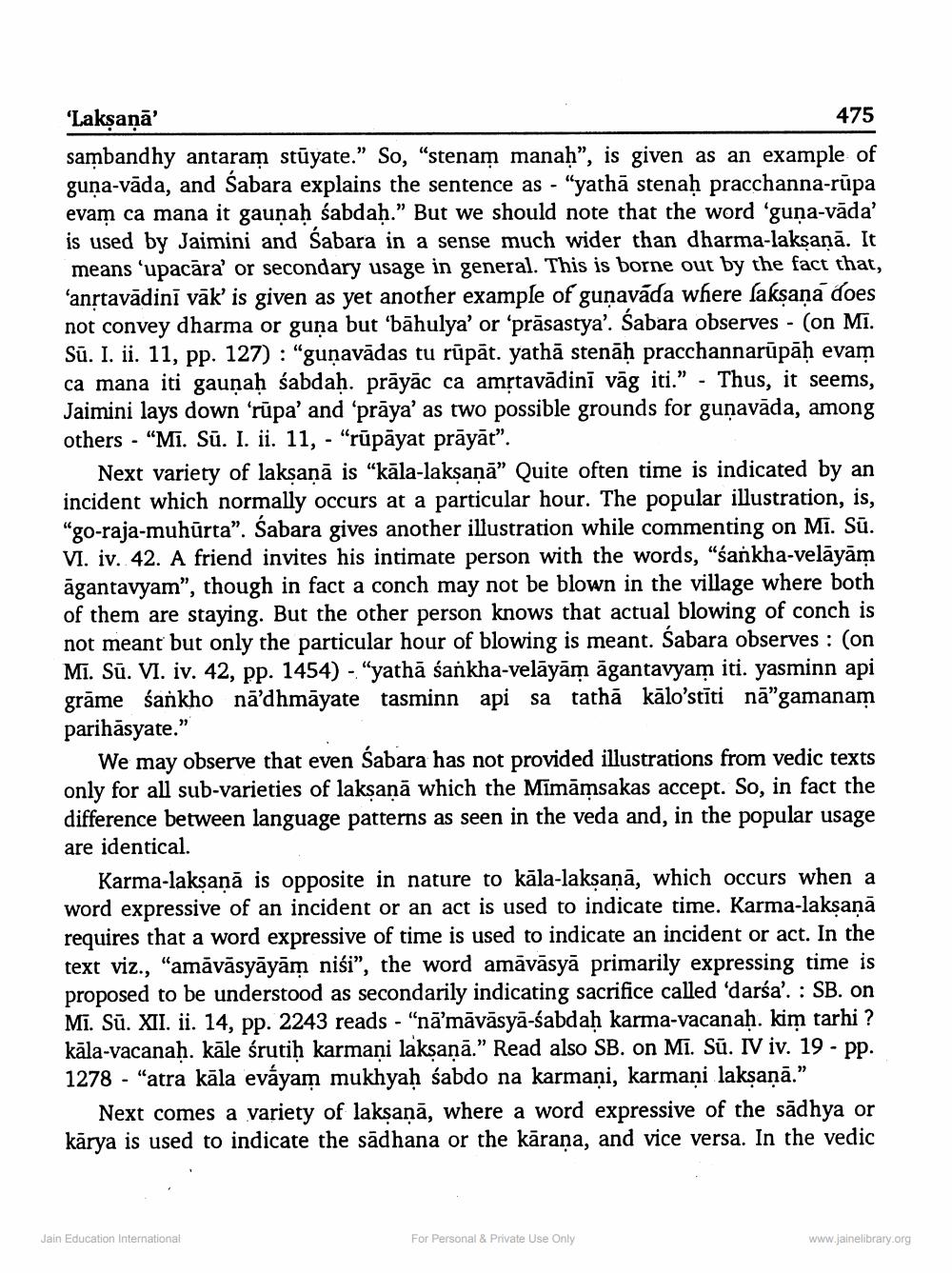________________
'Laksana'
475 sambandhy antaram stūyate.” So, “stenam manaḥ”, is given as an example of guna-vāda, and Sabara explains the sentence as - “yathā stenaḥ pracchanna-rupa evam ca mana it gaunaḥ śabdah.” But we should note that the word 'guņa-vāda' is used by Jaimini and Sabara in a sense much wider than dharma-laksanā. It means ‘upacāra' or secondary usage in general. This is borne out by the fact that, ‘anrtavādinī vāk' is given as yet another example of gunavāda where laksana does not convey dharma or guna but 'bāhulya' or 'prāsastya'. Sabara observes - (on Mi. Sū. I. ii. 11, pp. 127) : "guņavādas tu rūpāt. yathā stenāḥ pracchannarūpāḥ evam ca mana iti gauņaḥ śabdah. prāyāc ca amstavādinī vāg iti." - Thus, it seems, Jaimini lays down ‘rūpa' and 'prāya' as two possible grounds for guņavāda, among others - "Mi. Sū. I. ii. 11, - "rūpāyat prāyāt”.
Next variety of laksaņā is "kāla-laksaņā” Quite often time is indicated by an incident which normally occurs at a particular hour. The popular illustration, is, "go-raja-muhurta". Sabara gives another illustration while commenting on Mi. Sū. VI. iv. 42. A friend invites his intimate person with the words, “sankha-velayam āgantavyam”, though in fact a conch may not be blown in the village where both of them are staying. But the other person knows that actual blowing of conch is not meant but only the particular hour of blowing is meant. Sabara observes : (on Mi. Sū. VI. iv. 42, pp. 1454) - “yathā śankha-velāyām āgantavyam iti. yasminn api grāme sankho nā'dhmāyate tasminn api sa tathā kālo'stīti nā”gamanam parihāsyate."
We may observe that even Šabara has not provided illustrations from vedic texts only for all sub-varieties of laksanā which the Mimāmsakas accept. So, in fact the difference between language patterns as seen in the veda and, in the popular usage are identical.
Karma-laksanā is opposite in nature to kāla-laksanā, which occurs when a word expressive of an incident or an act is used to indicate time. Karma-laksanā requires that a word expressive of time is used to indicate an incident or act. In the text viz., "amāvāsyāyām nisi”, the word amāvāsyā primarily expressing time is proposed to be understood as secondarily indicating sacrifice called 'darśa'. : SB. on Mi. Sū. XII. ii. 14, pp. 2243 reads - "nā’māvāsyā-sabdaḥ karma-vacanaḥ. kim tarhi ? kāla-vacanah. kāle śrutih karmani laksaņā.” Read also SB. on Mi. Sū. IV iv. 19 - pp. 1278 - "atra kāla evayam mukhyah sabdo na karmani, karmaṇi laksaņā.”
Next comes a variety of laksanā, where a word expressive of the sādhya or kārya is used to indicate the sādhana or the kārana, and vice versa. In the vedic
Jain Education International
For Personal & Private Use Only
www.jainelibrary.org




